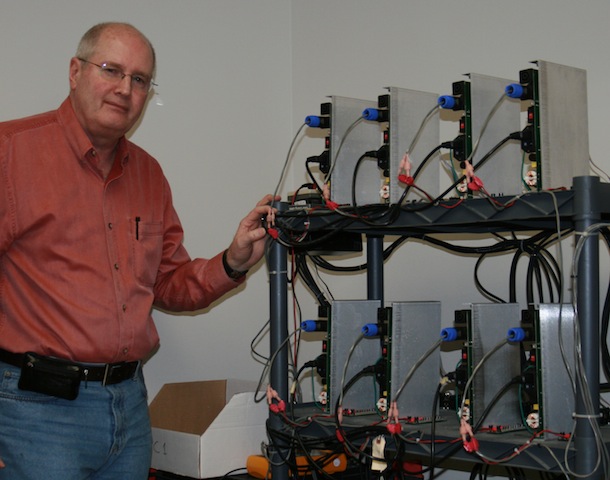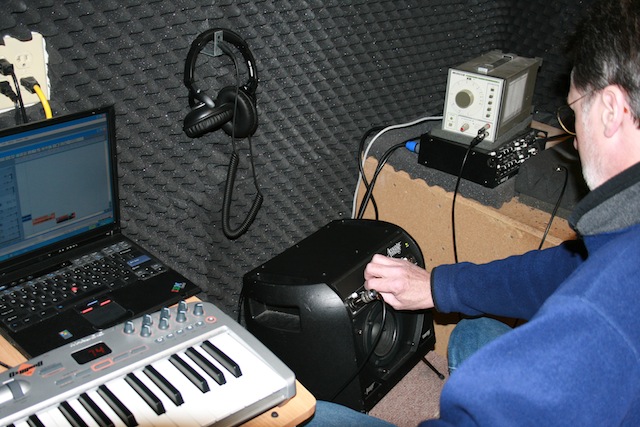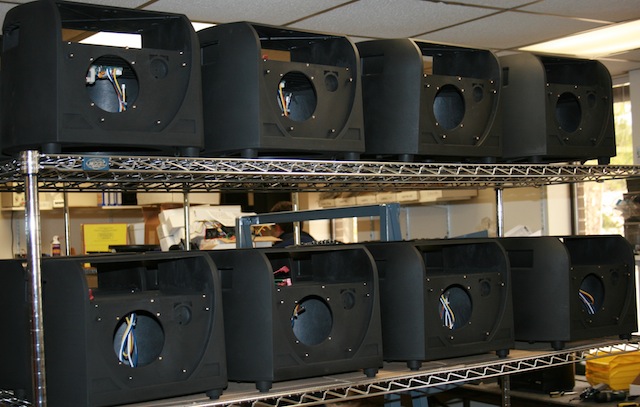Home » Jazz Articles » Built to Sound » Dedicated to Tone: Acoustic Image's Rick Jones
Dedicated to Tone: Acoustic Image's Rick Jones
A bassist himself, Jones became interested in the qualities of amplification in 1987 when he had a hard time finding an amp that lived up to his idea of what a bass amp should sound like. "The best bass amps, the ones everyone said were the best, just sounded terrible to me," Jones remembers. His ears perked up when he came across Walter Wood amp heads. Jones saw an alternative direction there, and began the thinking process that would eventually lead to his own company, Acoustic Image.

"My earliest ideas were about making amps that were compact. How do you get a full sound and keep it portable," Jones remembers. After work, Jones would design and test different approaches in his home workshop. Interestingly, Jones credits his career as a Telecommunications Engineer as helping along his designs. "As an engineer, I was trained to think in whole systems, about the overall process and so I thought about how everything affected everything else and what the trade-offs were with each decision," he says.
After a few years of trying out different approaches, Jones hit on the down-firing woofer, which allows his amplifiers to double the output by directing the sound out a cylinder at the floor beneath the amp. This then keeps the cabinet compact while providing a full tone. "By using the floor, it basically created a virtual driver and that made an immediate difference," Jones recalls. Eventually, prototypes were built, tested and plans were laid to attend the 1999 National Association of Music Merchants (NAMM) trade show.

"We got a very interesting reaction," Jones says describing the attention his amps received at his first NAMM show. "We made the cover of Bass Player magazine. That was when Ed Freeland at the magazine first coined the phrase about our amps: 'Looks like a mouse, sounds like an elephant,'" he proudly recalls. And in point of fact, Acoustic Image amps are unique in their sonic response and in their subtle looks. They almost fade into the background, and maybe nothing reflects Jones design ideas more than that. It's about presenting the sound of the instruments, about delivering the instrument tone correctly, not some flashy amp covers.
Jones continued to market his amps through word-of-mouth and by personally reaching out to music retailers and luthiers. "I knew there was nothing out there like our amps for the acoustic bass, so that was a logical market for us. I knew 'luthier to the stars' David Gage and told him what I was working on. He liked what I was doing and put it in his store. That's how we got a lot of New York players interested," Jones remembers. And when legends like famed bassist and Bill Evans Trio alum, Eddie Gomez came calling, he knew the hands-on marketing strategy had paid off. "He heard one of our amps and called me. I answered the phone and hear 'Hi, my name is Eddie Gomez, and I'm a bassist,'" Jones recalls. "I knew who HE was," Jones chuckles. And the list of musical luminaries having positive reviews about Acoustic Image amps keeps growing and includes Pat Martino, Jimmy Bruno, and Darol Anger.
From their debut at the 1999 NAMM show through mid-decade, Acoustic Image kept honing product design. The cabinet construct moved to a molded polymer material, which lightened overall weight and improved durability. Cabinet construct was also subcontracted out to save on costs. The cylindrical cone and baffling design matured and an effects interface was added to some lines. Today Acoustic Image combo amps include a 3-way speaker system powered by either a one or two channel preamp. Musicians can dial in their tone using a three-band EQ and an on-board digital effects module. Combo amps weigh in around 20 pounds.
Early on, electric guitar players seemed interested in using the amp head in their existing cabinets so Jones designed a removable head that could run any cabinet a guitarist pleased and resulted in the Clarus 1R becoming the first guitar oriented amp head for the company. Jones is also not afraid of teaming up with rival builders to supply musicians. "We entered into a relationship with Rich Raezer with our amp heads running those cabinets," Jones recalls—a move that less self-assured builders would have avoided, but that Jones saw as providing a needed element to the musicians' toolbox. Today, players have the choice of the head or combo series amps. Acoustic Image amps are also popular with keyboardist and, with two channel systems especially, vocalists. In an almost counter-intuitive move, Jones has met a progressively segmenting market with products that span those niches through quality, compactness and affordability.

Acoustic Image's facilities reside on a nondescript Raleigh, NC road mostly dedicated to other light industry. A small sign let me know I was at the right building. On the day I visited, the operation was manned by three long-time employees and Jones himself. But the place was busy with activity, and, of course, with the testing beds that each amp must pass through before being shipped. Jones walked me through the line from empty cabinets and waiting circuit boards to the testing rooms and the shipping dock. It's a small, efficient operations where each employee seems capable of handling whichever part of the operations needs doing (each is also a musician).
In the lobby Jones had assembled a line of amps that represented the evolution of his company. You could see the movement from dabbler to professional in the maturity of design. "We've always been about getting the musician the best product we can get them however that works for the player," Jones says, citing his willingness to incorporate ideas from players feedback. "And if you need anything, if the amps breaks down, you're calling right here and I might be the one answering the phone," he continues. That's what is reflected in that line of evolving amp models, a core belief about the quality musicians deserve in obtaining their own personal tone.
< Previous
Dandelion Clock
Comments
Tags
For the Love of Jazz
 All About Jazz has been a pillar of jazz since 1995, championing it as an art form and, more importantly, supporting the musicians who create it. Our enduring commitment has made "AAJ" one of the most culturally important websites of its kind, read by hundreds of thousands of fans, musicians and industry figures every month.
All About Jazz has been a pillar of jazz since 1995, championing it as an art form and, more importantly, supporting the musicians who create it. Our enduring commitment has made "AAJ" one of the most culturally important websites of its kind, read by hundreds of thousands of fans, musicians and industry figures every month.


















